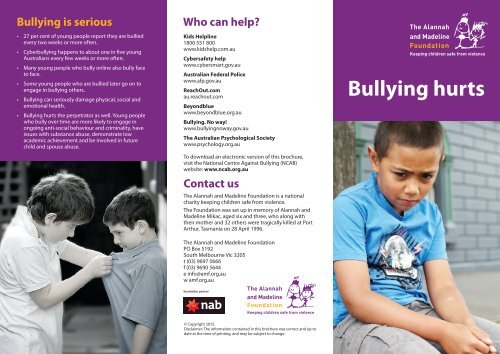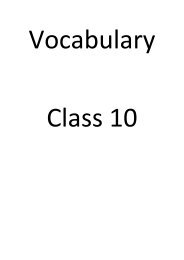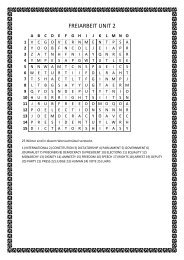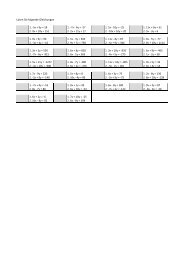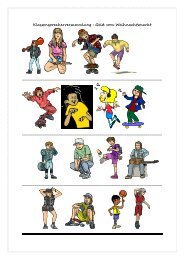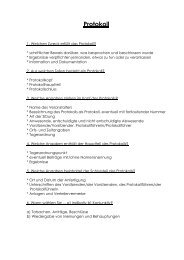Bullying Hurts_printview
Create successful ePaper yourself
Turn your PDF publications into a flip-book with our unique Google optimized e-Paper software.
<strong>Bullying</strong> is serious<br />
• 27 per cent of young people report they are bullied<br />
every two weeks or more often.<br />
• Cyberbullying happens to about one in five young<br />
Australians every few weeks or more often.<br />
• Many young people who bully online also bully face<br />
to face.<br />
• Some young people who are bullied later go on to<br />
engage in bullying others.<br />
• <strong>Bullying</strong> can seriously damage physical, social and<br />
emotional health.<br />
• <strong>Bullying</strong> hurts the perpetrator as well. Young people<br />
who bully over time are more likely to engage in<br />
ongoing anti-social behaviour and criminality, have<br />
issues with substance abuse, demonstrate low<br />
academic achievement and be involved in future<br />
child and spouse abuse.<br />
Who can help?<br />
Kids Helpline<br />
1800 551 800<br />
www.kidshelp.com.au<br />
Cybersafety help<br />
www.cybersmart.gov.au<br />
Australian Federal Police<br />
www.afp.gov.au<br />
ReachOut.com<br />
au.reachout.com<br />
Beyondblue<br />
www.beyondblue.org.au<br />
<strong>Bullying</strong>. No way!<br />
www.bullyingnoway.gov.au<br />
The Australian Psychological Society<br />
www.psychology.org.au<br />
To download an electronic version of this brochure,<br />
visit the National Centre Against <strong>Bullying</strong> (NCAB)<br />
website: www.ncab.org.au<br />
Contact us<br />
The Alannah and Madeline Foundation is a national<br />
charity keeping children safe from violence.<br />
The Foundation was set up in memory of Alannah and<br />
Madeline Mikac, aged six and three, who along with<br />
their mother and 32 others were tragically killed at Port<br />
Arthur, Tasmania on 28 April 1996.<br />
The Alannah and Madeline Foundation<br />
PO Box 5192<br />
South Melbourne Vic 3205<br />
t (03) 9697 0666<br />
f (03) 9690 5644<br />
e info@amf.org.au<br />
w amf.org.au<br />
<strong>Bullying</strong> hurts<br />
foundation partner<br />
© Copyright 2015.<br />
Disclaimer: The information contained in this brochure was correct and up to<br />
date at the time of printing, and may be subject to change.
What is bullying?<br />
<strong>Bullying</strong> is an ongoing misuse of power in relationships<br />
through repeated verbal, physical and/or social<br />
behaviour that causes physical and/or psychological<br />
harm.<br />
It can involve an individual or a group misusing their<br />
power over one or more persons.<br />
<strong>Bullying</strong> can happen in person or online, and it can be<br />
obvious (overt) or hidden (covert). <strong>Bullying</strong> of any form<br />
or for any reason can have long-term effects on those<br />
involved, including bystanders.<br />
Single incidents and conflicts or fights between equals,<br />
whether in person or online, are not defined as bullying.<br />
Types of bullying<br />
• Verbal or written abuse - such as targeted namecalling<br />
or jokes, or displaying offensive posters.<br />
• Violence - including threats of violence.<br />
• Sexual harassment - unwelcome or unreciprocated<br />
conduct of a sexual nature, which could reasonably be<br />
expected to cause offence, humiliation or intimidation.<br />
• Homophobia - and other hostile behaviour towards<br />
students relating to gender and sexuality.<br />
• Discrimination including racial discrimination -<br />
treating people differently because of their identity.<br />
• Cyberbullying - either online or via mobile phone.<br />
What is not bullying?<br />
• Mutual conflict which involves a disagreement, but<br />
not an imbalance of power. Unresolved mutual conflict<br />
can develop into bullying if one of the parties targets<br />
the other repeatedly in retaliation.<br />
• Single-episode acts of nastiness or physical<br />
aggression, or aggression directed towards many<br />
different people.<br />
• Social rejection or dislike is not bullying unless it<br />
involves deliberate and repeated attempts to cause<br />
distress, exclude, or create dislike by others.<br />
Signs that your child<br />
might be being bullied<br />
It’s not always easy to tell if a young person is being<br />
bullied, as sometimes they don’t want to disclose what’s<br />
happening to them.<br />
If you notice a significant change in behaviour, this could<br />
be cause for concern. Other signs can include changes<br />
to mood or eating and sleep patterns; withdrawal<br />
from family, social groups or friends; decline in school<br />
performance or unwillingness to attend; lost, torn or<br />
broken belongings; scratches or bruises, or implausible<br />
excuses for any of the above.<br />
What to do if your child<br />
is bullying others<br />
• Stay calm. Remember, the behaviour is at fault, rather<br />
than the child.<br />
• Make sure your child knows bullying behaviour is<br />
inappropriate and why.<br />
• Try to understand the reasons why your child<br />
has behaved in this way and look for ways to<br />
address problems.<br />
• Encourage your child to look at it from the other’s<br />
perspective, for example, “how would you feel if…”<br />
• Help your child think of alternative paths of action.<br />
• Provide appropriate boundaries for their behaviour.<br />
Things you can do if your<br />
child is being bullied<br />
1. Listen to your child’s story<br />
Try to listen to the whole story without interrupting. Be<br />
empathic, calm and validate what your child says. Ask<br />
what your child would like to happen, before making<br />
suggestions.<br />
2. Have a conversation about what happened<br />
Try not to let your emotions get involved as it might deter<br />
your child from talking to you. You’ll help them more if<br />
you stay calm. Remind your child it’s normal to feel hurt,<br />
it’s never OK to be bullied, and it’s NOT their fault.<br />
3. Make a record of events<br />
Note all incidents of bullying, including what, when and<br />
where they occurred, who was involved and if anybody<br />
witnessed the incidents.<br />
4. Work with your child’s school to find a solution<br />
Find out if the school is aware of the bullying and<br />
whether anything has been done to address the<br />
situation. Check your school’s bullying policy. Make<br />
an appointment to speak to your child’s teacher or<br />
wellbeing coordinator. Follow up with another meeting<br />
to ensure the situation is being addressed. Remember,<br />
they are there to help.<br />
5. Find other ways to support your child<br />
Coach your child to use neutral language or, if<br />
appropriate, joking language in response,<br />
and explain that it is better to stay<br />
away from unsafe situations<br />
if possible. Don’t offer to<br />
confront the person<br />
yourself.<br />
Encourage your child<br />
to get involved in<br />
extra-curricular<br />
activities such<br />
as sports and<br />
hobbies where<br />
they can spend<br />
time with other<br />
young people.


